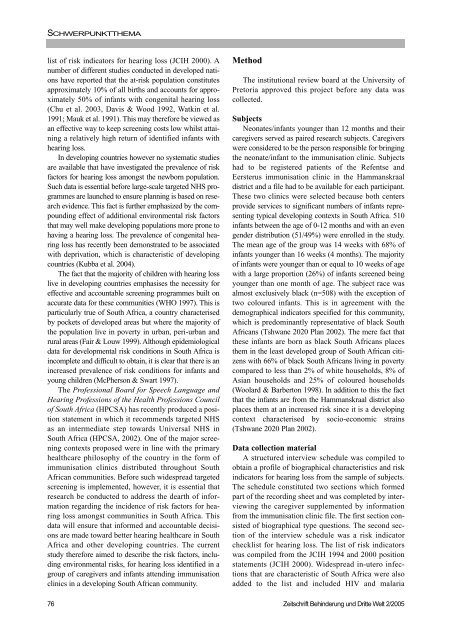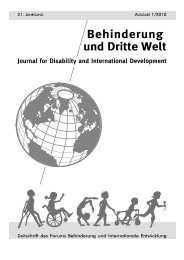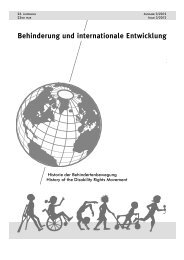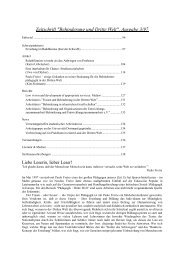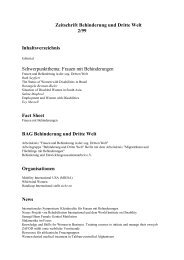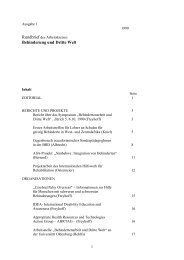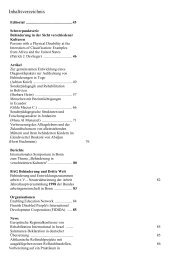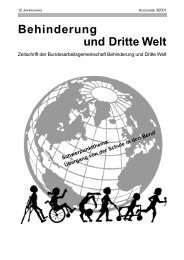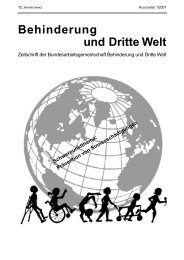Armut und Behinderung - Behinderung und Dritte Welt
Armut und Behinderung - Behinderung und Dritte Welt
Armut und Behinderung - Behinderung und Dritte Welt
You also want an ePaper? Increase the reach of your titles
YUMPU automatically turns print PDFs into web optimized ePapers that Google loves.
SCHWERPUNKTTHEMAlist of risk indicators for hearing loss (JCIH 2000). Anumber of different studies conducted in developed nationshave reported that the at-risk population constitutesapproximately 10% of all births and accounts for approximately50% of infants with congenital hearing loss(Chu et al. 2003, Davis & Wood 1992, Watkin et al.1991; Mauk et al. 1991). This may therefore be viewed asan effective way to keep screening costs low whilst attaininga relatively high return of identified infants withhearing loss.In developing countries however no systematic studiesare available that have investigated the prevalence of riskfactors for hearing loss amongst the newborn population.Such data is essential before large-scale targeted NHS programmesare launched to ensure planning is based on researchevidence. This fact is further emphasized by the compo<strong>und</strong>ingeffect of additional environmental risk factorsthat may well make developing populations more prone tohaving a hearing loss. The prevalence of congenital hearingloss has recently been demonstrated to be associatedwith deprivation, which is characteristic of developingcountries (Kubba et al. 2004).The fact that the majority of children with hearing losslive in developing countries emphasises the necessity foreffective and accountable screening programmes built onaccurate data for these communities (WHO 1997). This isparticularly true of South Africa, a country characterisedby pockets of developed areas but where the majority ofthe population live in poverty in urban, peri-urban andrural areas (Fair & Louw 1999). Although epidemiologicaldata for developmental risk conditions in South Africa isincomplete and difficult to obtain, it is clear that there is anincreased prevalence of risk conditions for infants andyoung children (McPherson & Swart 1997).The Professional Board for Speech Language andHearing Professions of the Health Professions Councilof South Africa (HPCSA) has recently produced a positionstatement in which it recommends targeted NHSas an intermediate step towards Universal NHS inSouth Africa (HPCSA, 2002). One of the major screeningcontexts proposed were in line with the primaryhealthcare philosophy of the country in the form ofimmunisation clinics distributed throughout SouthAfrican communities. Before such widespread targetedscreening is implemented, however, it is essential thatresearch be conducted to address the dearth of informationregarding the incidence of risk factors for hearingloss amongst communities in South Africa. Thisdata will ensure that informed and accountable decisionsare made toward better hearing healthcare in SouthAfrica and other developing countries. The currentstudy therefore aimed to describe the risk factors, includingenvironmental risks, for hearing loss identified in agroup of caregivers and infants attending immunisationclinics in a developing South African community.76MethodThe institutional review board at the University ofPretoria approved this project before any data wascollected.SubjectsNeonates/infants younger than 12 months and theircaregivers served as paired research subjects. Caregiverswere considered to be the person responsible for bringingthe neonate/infant to the immunisation clinic. Subjectshad to be registered patients of the Refentse andEersterus immunisation clinic in the Hammanskraaldistrict and a file had to be available for each participant.These two clinics were selected because both centersprovide services to significant numbers of infants representingtypical developing contexts in South Africa. 510infants between the age of 0-12 months and with an evengender distribution (51/49%) were enrolled in the study.The mean age of the group was 14 weeks with 68% ofinfants younger than 16 weeks (4 months). The majorityof infants were younger than or equal to 10 weeks of agewith a large proportion (26%) of infants screened beingyounger than one month of age. The subject race wasalmost exclusively black (n=508) with the exception oftwo coloured infants. This is in agreement with thedemographical indicators specified for this community,which is predominantly representative of black SouthAfricans (Tshwane 2020 Plan 2002). The mere fact thatthese infants are born as black South Africans placesthem in the least developed group of South African citizenswith 66% of black South Africans living in povertycompared to less than 2% of white households, 8% ofAsian households and 25% of coloured households(Woolard & Barberton 1998). In addition to this the factthat the infants are from the Hammanskraal district alsoplaces them at an increased risk since it is a developingcontext characterised by socio-economic strains(Tshwane 2020 Plan 2002).Data collection materialA structured interview schedule was compiled toobtain a profile of biographical characteristics and riskindicators for hearing loss from the sample of subjects.The schedule constituted two sections which formedpart of the recording sheet and was completed by interviewingthe caregiver supplemented by informationfrom the immunisation clinic file. The first section consistedof biographical type questions. The second sectionof the interview schedule was a risk indicatorchecklist for hearing loss. The list of risk indicatorswas compiled from the JCIH 1994 and 2000 positionstatements (JCIH 2000). Widespread in-utero infectionsthat are characteristic of South Africa were alsoadded to the list and included HIV and malariaZeitschrift <strong>Behinderung</strong> <strong>und</strong> <strong>Dritte</strong> <strong>Welt</strong> 2/2005


